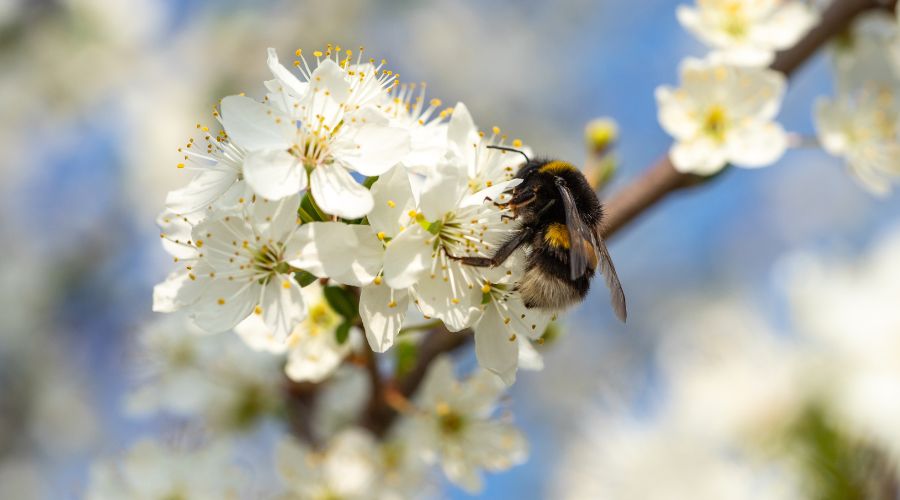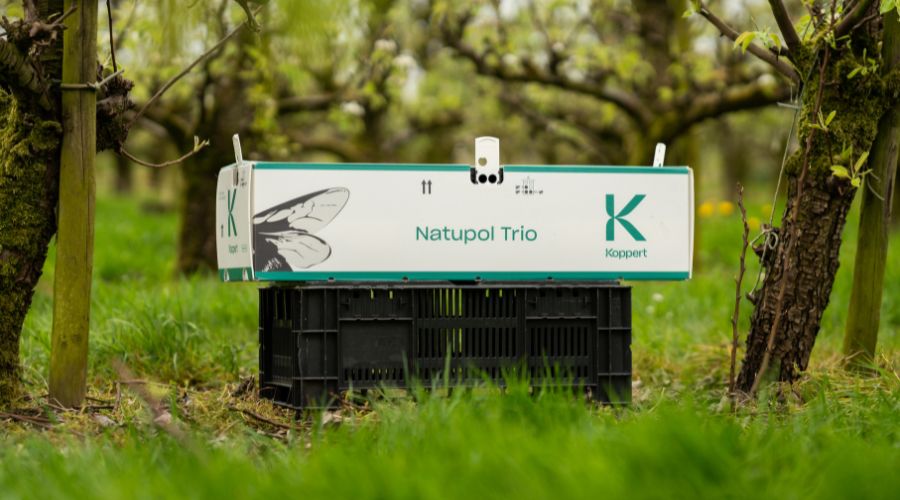Using biological controls in orchards and vineyards
24th February 2025
Stella Cubison, technical consultant for Koppert UK, discusses biological pest control options.

The recent loss of pesticides such as Calypso for important orchard pests such as aphids, as well as the impending withdrawal of Gazelle, Batavia and Explicit (the latter for caterpillar control – namely codling moth), certainly presents top fruit growers with challenges in maintaining a clean crop, but also brings with it the necessity to re-think how to manage pests differently.
By partnering with nature, Koppert has built an impressive portfolio of natural enemies to combat crop pests, supplying bumblebees for pollination, and developing microbials and biostimulants to support, protect and strengthen crops – improving plant health both above and below ground.
Opportunity for biological controls
Whilst there are several strategies that growers can adopt to encourage naturally occurring beneficial insects into the fields during late spring and summer (e.g. through the use of wildflower strips, flowering leys, cover crops etc.), extra help may be needed at key times of the year when pests are starting to emerge, or at specific stages in the pest life cycle which provide a window of opportunity for biological controls to be introduced.
An example of this is the use of hoverflies – the larvae of which are voracious predators of a wide range of aphid species, including rosy apple aphid (Dysaphis plantaginea) and woolly aphid (Eriosoma lanigerum).
Koppert offers two species of hoverfly – the ‘marmalade hoverfly – Episyrphus balteatus – (product name Syrphidend), and the slightly smaller species Sphaerophoria rueppellii, (product name Rophoria).
For convenience, both species are supplied as hoverfly pupae in small cardboard dispensing boxes. Starting from blossom, which ensures a food source is present for the adult hoverflies to feed on, introductions of Syrphidend are recommended to ensure these beneficial insects are present as early as temperatures allow, to build a population in the orchards as aphid levels are starting to increase.
The population of hoverflies can be further strengthened during warmer temperatures with subsequent introductions of Rophoria. Adult female hoverflies lay their eggs adjacent to aphid colonies. The resulting larvae of both species (which are active at night) are capable of consuming 300-500 aphids within their lifetime, ensuring a considerable contribution to aphid control during the growing season.
Biocontrol strategies
Codling moth is another pest causing increasing concern to growers of apples and pears, particularly given the more frequent occurrence of a second generation of the pest in late summer. Research carried out by Koppert France has proven that autumn treatments with entomopathogenic nematodes can reduce hibernating codling moth larvae by up to 80%, with fruit damage at harvest the following year reduced by 60-80%.
The nematodes, specifically the species Steinernema feltiae (product name Capirel) are applied to the larval stages of the pest during their descent from the trees in late summer/early autumn, with a repeat application before larval hatch in spring (late March – early April).
Capirel has also been proven to have good effects against apple sawfly, when applied to fruitlets on the orchard floor following the June drop or fruit thinning. The product also currently has plum fruit moth (Cydia funebrana) and summer fruit tortrix (Adoxophyes orana) on the label, with more pests due to be added in future.
Pest mites such as fruit tree red spider mite (Panonychus ulmi), two-spotted spider mites (Tetranychus urticae), together with species of rust and gall mites such as apple rust mite (Aculus schlechtendali) and vine erinose mite (Colomerus vitis) can often be successfully managed via the build-up of naturally occurring predatory mites such as Typhlodromus spp., if no broad-spectrum insecticides are used.
However, for newly planted orchards and vineyards, which have not yet had time to build up a sufficient population of natural enemies, or where predatory mites have been depleted through the use of chemical sprays, the generalist predatory mite species Amblyseius andersoni (product name Anso-Mite) can be introduced to help manage pest mites to acceptable levels, without being adversely affected by sulphur sprays.
Apple and pear suckers (Psylla spp.) can be a nuisance on top fruit crops in certain areas of the UK. The predatory flower bug Anthocoris nemoralis can provide excellent control of the pest and is also available from Koppert in bottles of 500 adult anthocorids.

Pollination
Pollination in top fruit is essential if high yields are to be achieved. Bumblebees are very efficient pollinators of fruit trees as they work longer hours and can tolerate colder temperatures and higher windspeeds than other species of pollinator. Koppert offers both Natupol Trio and Booster hives, to cover a range of different orchard scenarios, ensuring your crop receives the best possible pollination attention via our native buff tailed bumblebees (Bombus terrestris audax).
Insect monitoring and control of wasps (particularly in vineyards at harvest) is an important component of pest management during the growing season. Koppert also offers insect traps and attractant for SWD and wasps, together with pheromone traps for a wide range of pest moths.
About the expert
Koppert has long been providing biological control and pollination advice and products to growers, since its founder, Dutch cucumber grower, Jan Koppert, first successfully used the predatory mite Phytoseiulus persimilis against two-spotted spider mite (Tetranychus urticae) in the late 1960s.
Since then, the company has gone from strength to strength and now has a global presence with 30 subsidiaries worldwide, selling a wide range of products in more than 100 countries. Contact your nearest Koppert consultant or distributor, or visit www.koppert.co.uk for more information.
